#but replacing the original legion with kid versions was antagonistic
Text
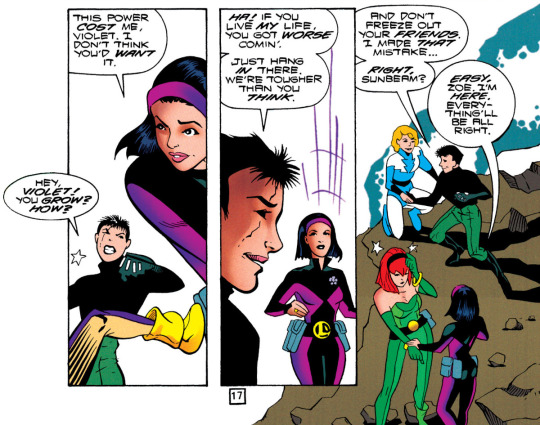
June 1998. Among DC's more infuriating editorial tendencies is a penchant for blowing up characters and continuity and then later bringing back the discarded versions very briefly, either to stomp on them all over again, or just to remind you that the earlier version existed, but you're not allowed to have it anymore. To exemplify the point, here's a scene from LEGION OF SUPER-HEROES #105 where the cutesy reboot Legion's Shrinking Violet encounters the older, butch version of herself from the pre-Zero Hour series.
(The visual parallel between the older Vi and Lightning Lass and the younger Violet comforting Kinetix is just bait — there was nothing to see there.)
#comics#legion of super heroes#legion of superheroes#tom peyer#roger stern#jason armstrong#ron boyd#shrinking violet#salu digby#lightning lass#ayla ranzz#kinetix#zoe saugin#if the reboot had been an alternate version like ultimate spider-man#it would have been fine#but replacing the original legion with kid versions was antagonistic#and it eventually dawned on me that the reboot#was specifically DESIGNED to erase everything i had ever liked#or thought worthwhile about the original legion#including vi growing up to be a grizzled 30something butch lesbian!#the reboot was such garbage#and the one after it was in some ways worse#although at least it was less cutesy
18 notes
·
View notes
Text
Ninja Gaiden Spotlight: Ninja Gaiden (Arcade) & Ninja Gaiden (NES)
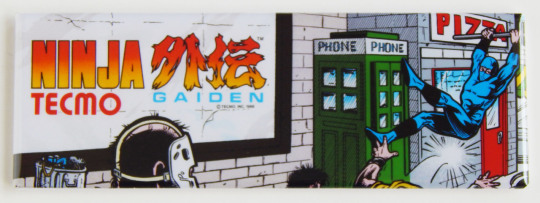
Ninja Gaiden is a strange franchise for a number of reasons. Although most people are familiar with the name through the NES games or the later Xbox-born revival, Ninja Gaiden got its start in the arcades. Curiously, although Tecmo is a Japanese company, Ninja Gaiden (Arcade) was first released in North America. While the series technically began with the arcade game, however, it didn't really hit the radar of most players until the first NES game, also titled Ninja Gaiden. In this article, we'll be taking a look at both of those games.
Ninja Gaiden (Arcade)

Original Release Date: October 1988 (NA)
Original Hardware: JAMMA PCB
Ninjas were a hot-ticket item in the 1980s, and just about everyone around the world knew it. Once renowned for their ability to stay out of sight and stick to the shadows, ninjas were suddenly showing up in all kinds of wild places. One popular sub-genre of the ninja boom was the American ninja. Sometimes these would literally be American characters who somehow became ninjas, as seen in the astonishingly long-running American Ninja series of films. Other works of fiction simply placed groups of ninjas in American locations, typically as antagonists, as in Daredevil or the Teenage Mutant Ninja Turtles. But if there was one other kind of theme that North Americans were in love with during the 1980s, it was the fish-out-of-water story. Just imagine the laughs you can get from putting a stranger in a land that seems mundane to us but positively bizarre from the character's point of view. Or don't imagine and just watch Crocodile Dundee. I won't judge you.

The funny thing is, not all of these stories came out of the minds of American creators. As infatuated as Westerners were with Japanese culture in the 1980s, Japanese were equally head-over-heels with the United States. Thus, we have Ninja Gaiden, a game that somehow started a successful franchise in spite of its main redeeming trait being just how stupid it is. Initially released in North America in 1988, it's a side-scrolling beat-em-up in the style of Double Dragon. One or two players guide their ninja character through stages based on major American tourist traps, dodging traffic in New York City, jumping across the neon-lit signboards of Vegas, and kicking Jason Voorhees look-alikes into the Grand Canyon. The story goes that your ninja heroes have been hired to take down an evil, sword-wielding descendant of Nostradamus named... Bladedamus. No, I'm not kidding.
As these kinds of games go, Ninja Gaiden is not a very good one. It's stingy and quite difficult, and although you have an assortment of moves at your disposal, the only truly effective one is a leaping throw. There are some interesting gimmicks woven into the gameplay, such as the button on the top of the stick that allows you to grab onto overhead handholds and so on. You can also run up and flip off of walls, and if you happen to have the sword power-up at the time, you can launch a deadly attack by doing that. In general, there's quite a bit more jumping and platforming than you would usually see in a belt-scrolling brawler. Many of the fundamental rules of the genre weren't etched in stone by this point, so you tended to see a lot of experimental titles like this.
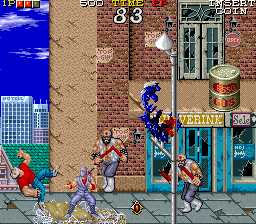
If Ninja Gaiden has any real merit, it can be found in the sheer amount of bizarre nods to Americana it contains. The game carelessly skirts the legal line with its parodies and homages, most notably in its inclusion of the pro wrestling tag-team Legion of Doom as recurring bosses. Every time they appear, they’re accompanied by a barely-disguised copy of Black Sabbath’s Iron Man, which was their ring entrance music at the time. The Legion of Doom were regularly wrestling in Japan at the time, so it’s not too hard to see how the inspiration struck the development team. At the same time, it caused some problems when the game was re-released on the Wii Virtual Console. The music had to be replaced to avoid legal issues. Some of the graphics were altered as well, for mostly similar reasons.
That Virtual Console port represents one of the few times the arcade version of Ninja Gaiden came to a home console. It was ported to a number of home computers in Europe under the title Shadow Warriors, and had a handheld port to the Atari Lynx. It was also included as an unlockable bonus game in Ninja Gaiden Black on the Xbox. It’s not hard to get your hands on this game if you really want to, but outside of its historical importance, I’m not sure what you would get out of it. I suppose we can thank Ninja Gaiden for introducing us to Ryu Hayabusa, but he was coming one way or another anyway.

Ninja Gaiden (NES)

Original Release Date: December 9, 1988 (JPN)
Original Hardware: Nintendo Entertainment System
The NES version of Ninja Gaiden was developed alongside the arcade version, and although it shares a name and some promotional artwork, it’s a very different game. While it seems like both games came out of the same basic idea of a Japanese ninja in America, the NES version quickly ditches the garish Americana. Only the first level and its boss encounter show any signs of the American setting, and Ryu’s journey takes him around the world by the end of it all. The arcade game was chasing after the hot side-scrolling beat-em-up genre, but on consoles the platformer genre was much more popular. There was also no real need to shake down players for quarters, so the development team could take a marginally gentler approach to the difficulty. Well, they could have, anyway.
To be fair, Ninja Gaiden does pull its punches early on. After watching a very cool opening cinema showing Ryu’s father falling in a dramatic duel, the player is tossed into the game’s first level. It’s pretty much a straight horizontal shot to the end of the level, with a few obstacles and enemies placed in the way to teach the player the basic mechanics. At first, the player isn’t required to do any climbing, and every enemy comes at Ryu slowly from the right side of the screen. About halfway through, it turns up the heat a little, with speedy enemies approaching from the rear and structures that the player is forced to climb in order to proceed. It’s extremely likely the player will take a few hits along the way, which will teach them how Ryu flies back when he takes damage. Almost every item you can encounter in the game makes an appearance in the first stage, too. This is as much of a tutorial as the game is willing to give you.

The first boss is also quite the softy. He slowly marches toward the player, stopping every so often to swing a couple of times with his machete. He’s short enough to jump over, and his weapon has a shorter reach than Ryu’s Dragon Sword. If you happen to get too close, ducking will put you underneath his swing. It’s almost impossible to lose to him unless you really haven’t come to grips with the basics of controlling Ryu. After beating the boss, you’re treated to another dramatic cinema scene, setting the pace for the game to come.
Cut-scenes like these were a rarity at the time, and although the story is completely absurd, having it depicted with such detail grants it a much bigger impact than the equally silly stories of other games of the time. This emphasis on dramatic camera angles and moody settings makes a bit more sense when you find out that Ninja Gaiden was among the first video games worked on by a young Masato Kato, who would go on to work on the scenarios of games like Chrono Trigger, Final Fantasy 7, and Final Fantasy 11. A superb soundtrack by Keiji Yamagishi and Ryuichi Nitta accentuates the ever-changing atmosphere that the game builds from level to level. Like many of the best soundtracks of the era, the music sets the beat for the player’s actions throughout the game. Most of the background music has a frantic quality to it that has you on the edge of your seat the whole time.
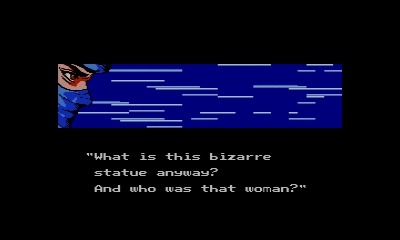
The second act starts off similarly to the first, having the player make their way out of a prison along a largely horizontal layout. The main difference here is that there are some small vertical elements and the odd bottomless pit. It’s possible that you might be knocked to your death if you play carelessly, but quite unlikely. Coming out of the prison into the fresh air, the game starts to show its true face for the first time. The ratio of safe footing to pits begins to tilt against the player. There are quite a few small ledges patrolled by enemies that lob projectiles at the player, requiring careful timing to avoid being knocked back to where you started from, or worse, into a pit. The only act of mercy on the game’s part is in how it spreads out the power-ups and sub-weapons in this stage. You’re usually given the most helpful possible item for the situation at hand, and furnished with plenty of magic points to use them with. Thanks to that, most players should be able to make their way through this act. The boss is quite similar to that of the first stage, albeit taller and with a longer reach. This requires a better stick-and-move strategy, but if you’ve made it this far, you shouldn’t have too many problems.
An infamous enemy makes its first appearance in the third act of the game. To observers, it’s merely a bird, but to veterans of the 8-bit era, it’s a symbol of a thousand missed jumps and aggravating deaths. Its speedy, erratic movements can make it hard to take down quickly, and it’s almost always placed in positions where it can cause the most suffering. Where there is a tiny ledge surrounded by bottomless pits, there is the bird. Where there is a tricky jump, there is the bird. Where there is a seemingly safe, wide stretch of land, there are two birds. The combinations of enemies and significantly more dangerous layouts make the third act a real stepping-up point in terms of difficulty. By comparison, the boss is a bit of a relief. It jumps in a predictable pattern from one side of the screen to the other, occasionally firing a volley of bullets as it takes off. It’s a different challenge from the first two bosses, but once you pick up its pattern, it’s not too tough to take down.
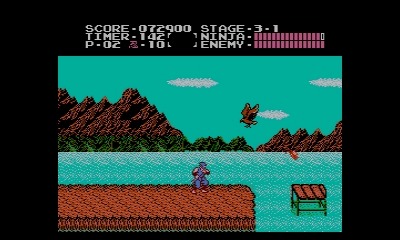
In my experience, the fourth act is a make-or-break point for a lot of players. The first couple of stages aren’t too much harder than what you’ve already been through, though the ledges are smaller and patrolled by more dangerous mixes of enemies. Bats are especially annoying with their lazy parabolic movements, and it’s almost impossible in places to actually take them out permanently since their spawn point appears mid-air. You’ll also have to start dealing with speedy ninjas that drop seemingly out of nowhere. It’s the third stage of the act where business really picks up. If you haven’t learned the ins and outs of Ryu’s capabilities by this point, you’re going to get bounced around like a little pinball. Power-ups are place in trickier places, and magic points to power your weapon attacks aren’t nearly as plentiful.
The boss of this act, Kelbeross, has the most random patterns we’ve seen from a boss enemy yet. He takes the form of a pair of dogs that leap around the room firing deadly balls of energy at regular intervals. Unlike the previous three boss rooms, this one has a couple of columns placed in it. They can be used as perches for Ryu, but it seems like they’re really there to make Kelbeross’s leaps harder to predict. One of the pair falls quite quickly, but the other one will put up a fairly good fight. You not only need to predict where his leaps will take him, but also keep an eye out for his shots. A good sub-weapon can make a huge difference here, provided you have the magic points to use it. Kelbeross isn’t quite as tough as the stage that precedes him, but he is the first boss to show any real teeth.
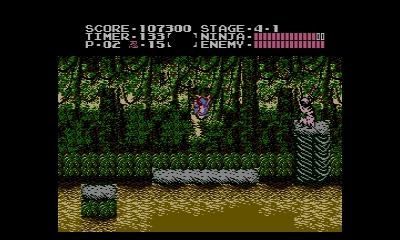
Get past that boss, and you’re onto the fifth act. For the most part, there’s nothing here you haven’t already seen, but if you don’t hate birds by now, you will. One of the favorite tricks of the designers in this act is to throw a bird out as you’re leaping to a ladder. If you don’t react with precision, you’ll almost certainly get sucker-punched. This act also contains one of the first real moments of cruelty in Ninja Gaiden. There’s a section where you need to carefully drop and stick to the wall in order to jump to a lower platform. This is tricky enough on its own, but the game also tosses out a bird here just to mess with you. If you can get through there, the rest of the act isn’t too bad, but that is a sign of the game’s changed intent towards the player. The line is to be drawn here, and not much farther. The act culminates in an oddly anti-climactic battle against a character named Bloody Malth. He can call down lightning, and the very act of the battle taking place on a rooftop makes things much more dramatic. He’s also the first boss to get a cut-scene before the fight, giving this fight a personal touch the others lacked. He goes down easily enough if you get in close, crouch, and slash like a madman, though.
Up to this point, Ninja Gaiden is a tough game, but largely a fair one. The NES had a lot of extremely difficult games, but not many of those games were as highly-regarded as Ninja Gaiden. I firmly believe it’s because this game gives the player enough rope early on to really get into the game and its mechanics. You’re so invested by the time it gets truly vicious that you want to see it through anyway. Even with that determination, very few players see Ninja Gaiden through to its close, and the sixth act is almost certainly why. There’s a lot to break down here, but let’s start with a programming bug that the developers liked enough to keep in. Usually in this game, if you lose a life, you’ll start back at the beginning of the current section. You’ll lose a little progress, but nothing major. And so it goes in the sixth act, until you reach the final boss gauntlet. If you die there, the game sends you all the way back to where you fought Bloody Malth. It’s a long, draining road to make the first time. Every trip after that feels like it’s asking for another little piece of your soul.

The sixth act is really, really hard. Ninjas with jetpacks fly by, lobbing shuriken at all sorts of angles. Speedy little leapers scoot around, jumping erratically. Birds, bats, enemies with projectiles, leaping ninjas, and every other thing the game can muster is thrown at you in increasingly hard-to-manage combinations. The Whirlwind Slash weapon helps a lot here, but it chews through magic points far faster than you’ll earn them. Almost every second of the climb sees you assaulted from multiple directions, and bottomless pits are everywhere. It’s all very unpleasant. And it’s nothing compared to the last set of bosses waiting at the end.
Now, as we’ve established, if you die at the final boss, you’ll be kicked all the way back to the first section of the sixth act. One small bone the game tosses you is that any bosses you beat stay dead, at least until you have to continue. The first boss of three has a tough-to-read pattern, and he commandeers much of the chamber in which you fight him. Making things tougher is that he is not your actual target. If you have the right sub-weapon, things go a little faster here, but it’s still pretty tricky. If you beat him, you get the usual end-of-stage roll where your remaining magic points and life points are added to your score, leaving you with a fresh life bar and zero magic points. This is bad, because you’re immediately thrown into a fight with the big boss Jaquio. He’s easy enough if you have the fire sub-weapon and a stock of magic, but unless you die and crawl all the way back here after beating the first boss, you won’t even have a single magic point to your name.
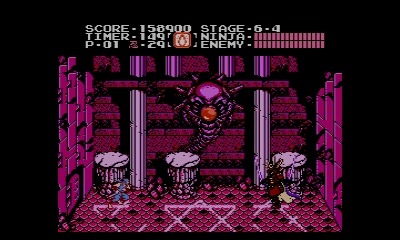
If your timing is good, you might be able to move between his shots and get your licks in. It’s easier to take the cheap way out, though. If you time it just right, you can get Jaquio to knock you outside of the screen boundaries near the top of the screen, giving you a convenient perch from which you can attack and dodge. Short of taking the loss and coming back with a proverbial ninja magic bazooka, this is the only method by which I’ve ever been able to beat Jaquio. I guess I should just be happy I can still beat him at all. Take him down, and the end-of-stage rigmarole happens again, once again ensuring that you won’t have any magic points for the next fight.
Yes, it’s not over yet. You now have to fight the demon statue itself in its true form. This is a large, impressive-looking boss that uses the trick of having the enemy be a background layer. There are three targets on his body, and unless you foolishly collide with the statue itself, you really only need to worry about the predictable energy bursts it rains down on you. Slice up its heart, and you’ll finally get the ending you so richly deserve. Individually, none of the three final bosses are all that bad, but the gauntlet combined with the added restrictions placed on you make it really hard to persevere. The ending is awesome, at least. I don’t know what I would have done if I had fought my way through all of that only to get a simple congratulations.

Even with the nasty difficulty spikes and cruel change of rules at the end of the game, Ninja Gaiden is an amazing game. There are a number of reasons for that. The controls are tight, Ryu’s moveset provides the player with a lot of fun options, and the large amount of sub-weapons gives you an opportunity to form your own style. The presentation is outstanding, and the story at least makes an effort. The way the game eases you in so that you’re invested in overcoming the more difficult hurdles is also quite the clever trick. I imagine most people give up anyway, but the amount of nastiness the average player is likely to put up with before reaching that point is surely the mark of some sort of achievement.
Difficulty balancing is an issue the Ninja Gaiden series would always struggle with across its many forms. While the first game doesn’t quite nail it thanks to the final boss gauntlet, I think this is as close as any of its developers would get to a satisfying level of challenge until the Xbox revival. But I’ll explore that more when I talk about the other two games in the NES trilogy next time around.
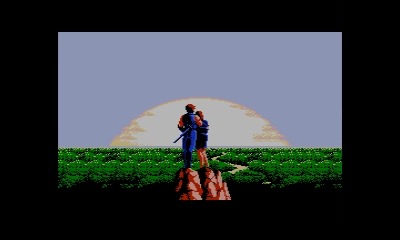
Next: Ninja Gaiden 2 & Ninja Gaiden 3
Previous: Introduction
If you enjoyed reading this article and can’t wait to get more, consider donating to the Post Game Content Patreon. Just $1/month gets you early access to articles like this one, along with my undying thanks.
1 note
·
View note